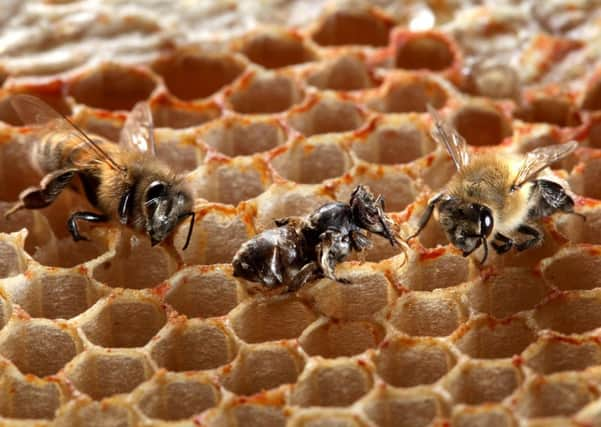A growing disease threat to bees


In England there are around 44,000 beekeepers and the average beekeeper keeps six hives. In the US, there is one beekeeper who has 80,000 hives.
In other words, a single beekeeper in South Dakota keeps a third as many hives as there are across the UK.
Advertisement
Hide AdAdvertisement
Hide AdI say he’s in South Dakota but actually he’s only there part of the time. American beekeepers don’t stay in one place. The majority load their beehives on to flat back trailers and ship them to the next place where a crop needs pollinating.
Every January around 1.5m hives of bees are taken to California to pollinate the state’s biggest agricultural export crop – almonds. On a conservative estimate there are over 30bn bees being moved across the country each year just to pollinate huge fields of almonds. There are plenty of other crops to pollinate and the bees are moved around according to the season and needs of crops.
Each time they arrive to pollinate a crop the farmer pays the commercial beekeeper a hefty fee but the cost of labour, transport and equipment means it’s a hard way to make a living.
You may imagine that the coming together of 30bn bees from across the country would be a joyous event, providing wonderful opportunities for people meeting up. I’m sure that annual meetings between farmers and beekeepers must be great fun but the artificial meeting of 30 billion animals is not without its consequences.
Advertisement
Hide AdAdvertisement
Hide AdThis gigantic annual encounter between bees from across America has impacts on British agriculture which we need to take seriously. It only requires a small number of bees somewhere in an American almond grove to be carrying a disease or a pest and it won’t be long before it spreads like wildfire across the gigantic orchards. Once it has spread from bee to bee, the hives are then placed on a truck and driven off to a new location – where the bees infect a whole new neighbourhood.
It’s not good for a bee to feed on only one thing for two to three weeks. Like humans they need a variety of trace elements in their diet and they can’t get them all from one food source. A monoculture diet tends to weaken them and leave them susceptible to problems. Chance encounters between several billion bees are almost guaranteed to spread those problems.
A whole wave of significant new threats to bees have reached America in recent years and the mass transportation of bees provides the perfect mechanism to move those diseases across the continent.
The small hive beetle started eating its way through the lava of bee colonies in 1998 and has left many of them a foul gelatinous goo. ‘Crazy Rasberry’ ants also enjoy eating lava. They arrived in a port in Houston in 2002 and quickly spread. Then there’s the Kashmir bee virus, the Israeli acute paralysis virus and the Kakugo virus all of which have only been identified in America recently. But none of these problems compare to the biggest of all of the pests – the varroa mite – an unpleasant parasite originating from Asia which lives on a bee and sucks its energy. It is now the biggest single threat to bee populations across the world, including the UK.
Advertisement
Hide AdAdvertisement
Hide AdThe huge scale of the transport of bees across the US makes the transmission of any threats much more likely and much more rapid. There is, therefore, every prospect that we will face a growing problem of wave after wave of new threats to our most important pollinator.
It only takes one infected bee to get into the country to move a disease or a parasite across oceans or mountain ranges which have held it in check for millions of years.
A robotic future?
Concerned by disease amongst bees, US researchers have tried using small robot pollinators to replicate the job of bees to mass pollinate huge monoculture plantations and the results are mixed.
Electronic bees can just do the job, on a few flowers, but are slow, expensive and each needs to be re-engineered to pollinate a different plant.
Advertisement
Hide AdAdvertisement
Hide AdI prefer to think that it’s possible that a more sensible solution might be to take bee welfare more seriously and adapt our agricultural methods to limit transportation and provide bees with more varied diets.